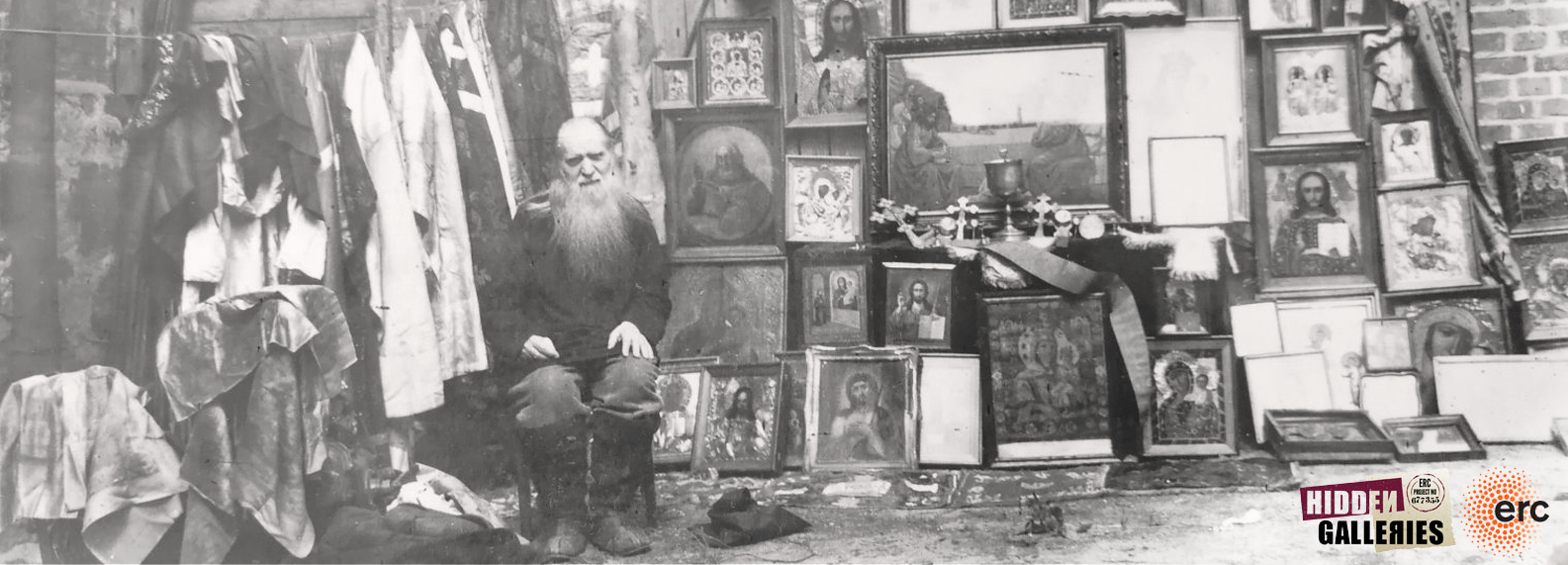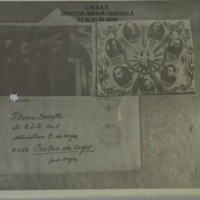Postcards of Romanian Greek Catholic martyr bishops
Item
Title
Postcards of Romanian Greek Catholic martyr bishops
Cărți poștale ale Episcopilor Greco Catolici martiri
Description
These images are of postcards that circulated in the 1970s of the Greek Catholic bishops that refused the forced unification of their church with the Romanian Orthodox Church. The bishops were all arrested, imprisoned and either died in prison or in forced domicile.
The two images show the Greek Catholic Bishops Ioan Suciu (1953), Valeriu Traian Frențiu (1952), Vasile Aftenie (1950), Ioan Bălan (1959), Alexandru Rusu (1963), Tit Liviu Chinezu (1955), and Cardinal Iuliu Hossu (1970). Their photos were then collaged together and artistically framed around an image of the Blaj Greek Catholic Cathedral. Because Cardinal Iuliu Hossu appears in the medallion with the date of his death, we can safely date the postcards in the 1970s.
The first image also has a photo of Bishop Ioan Dragomir dressed in his cassock with cincture and with an episcopal cross. These visual clues also serves to narrow the date in which the postcards were produced to before 1985 when bishop Ioan Dragomir died since the file in which these images are found does not give any explanations of the postcard or the picture. We can only assume that both bishop Dragomir’s staged photo and the postcard of the martyr bishops were similarly used as a means to inform the community, through these visual messages, that the Greek Catholic bishops had died for their faith in the communist prisons and yet the Church continues to live on in the underground.
The second image of the same postcard of the martyr bishops comes from the Informative File of Greek Catholic Bishop Ioan Ploscaru. The document contains the postcard, a picture of all the Greek Catholic bishops taken before 1948 and the envelope in which these pictures were presumably sent. The document represents the secret police practice of making photographic evidence of problematic correspondence. After it was copied, the letter was probably posted on to the addressee. In this case, the letter was sent to Florea Dosoftei at Curtea de Argeș. What made this letter suspicious was probably the fact that it was correspondence between the Greek Catholic bishop Ioan Ploscariu and Fr Dosoftei Florea, a monk in the Orthodox Church. They were both imprisoned during the communist regime.
The images selected were part of two different surveillance files of two underground Greek Catholic bishops. Variants of these postcards can be found in Greek Catholic communities today leading to the conclusion that they were widespread in the period and fairly accessible inside the underground community, and thus a useful method of passing information on the community through visual rather than textual means.
These postcards are photographed and attached to two different multiple volumes informative files that space out from 1964 to the late 1980s. The files are preserved in the archive as CNSAS I3560 vol 7 and I262256 vol 4. They also contain surveillance images, intercepted correspondence, notes from informants, religious texts and samizdat.
The two images show the Greek Catholic Bishops Ioan Suciu (1953), Valeriu Traian Frențiu (1952), Vasile Aftenie (1950), Ioan Bălan (1959), Alexandru Rusu (1963), Tit Liviu Chinezu (1955), and Cardinal Iuliu Hossu (1970). Their photos were then collaged together and artistically framed around an image of the Blaj Greek Catholic Cathedral. Because Cardinal Iuliu Hossu appears in the medallion with the date of his death, we can safely date the postcards in the 1970s.
The first image also has a photo of Bishop Ioan Dragomir dressed in his cassock with cincture and with an episcopal cross. These visual clues also serves to narrow the date in which the postcards were produced to before 1985 when bishop Ioan Dragomir died since the file in which these images are found does not give any explanations of the postcard or the picture. We can only assume that both bishop Dragomir’s staged photo and the postcard of the martyr bishops were similarly used as a means to inform the community, through these visual messages, that the Greek Catholic bishops had died for their faith in the communist prisons and yet the Church continues to live on in the underground.
The second image of the same postcard of the martyr bishops comes from the Informative File of Greek Catholic Bishop Ioan Ploscaru. The document contains the postcard, a picture of all the Greek Catholic bishops taken before 1948 and the envelope in which these pictures were presumably sent. The document represents the secret police practice of making photographic evidence of problematic correspondence. After it was copied, the letter was probably posted on to the addressee. In this case, the letter was sent to Florea Dosoftei at Curtea de Argeș. What made this letter suspicious was probably the fact that it was correspondence between the Greek Catholic bishop Ioan Ploscariu and Fr Dosoftei Florea, a monk in the Orthodox Church. They were both imprisoned during the communist regime.
The images selected were part of two different surveillance files of two underground Greek Catholic bishops. Variants of these postcards can be found in Greek Catholic communities today leading to the conclusion that they were widespread in the period and fairly accessible inside the underground community, and thus a useful method of passing information on the community through visual rather than textual means.
These postcards are photographed and attached to two different multiple volumes informative files that space out from 1964 to the late 1980s. The files are preserved in the archive as CNSAS I3560 vol 7 and I262256 vol 4. They also contain surveillance images, intercepted correspondence, notes from informants, religious texts and samizdat.
Aceste imagini sunt ale unor cărți poștale care au circulat în anii '70 reprezentând episcopii greco-catolici care au refuzat unificarea forțată a bisericii lor cu Biserica Ortodoxă Română. Episcopii au fost toți arestați, închiși și fie au murit în închisoare, fie în domiciliu forțat.
Cele două imagini îi prezintă pe episcopii greco-catolici Ioan Suciu (1953), Valeriu Traian Frențiu (1952), Vasile Aftenie (1950), Ioan Bălan (1959), Alexandru Rusu (1963), Tit Liviu Chinezu (1955) și pe cardinalul Iuliu Hossu (1970). Fotografiile lor au fost apoi puse în colaj și încadrate artistic în jurul unei imagini a catedralei greco-catolice din Blaj. Deoarece cardinalul Iuliu Hossu apare în medalion cu data morții sale, putem să datăm în siguranță cărțile poștale în anii '70.
Prima imagine are și o fotografie a episcopului Ioan Dragomir îmbrăcat în sutană cu cinctură și cu cruce episcopală. Aceste indicii vizuale servesc, de asemenea, pentru a restrânge data la care au fost produse cărțile poștale înainte de 1985, când episcopul Ioan Dragomir a murit, deoarece dosarul în care se găsesc aceste imagini nu oferă nicio explicație a cărții poștale sau a imaginii. Putem presupune doar că atât fotografia în scenă a episcopului Dragomir, cât și cartea poștală a episcopilor martiri au fost folosite în mod similar ca mijloc de informare a comunității, prin aceste mesaje vizuale, că episcopii greco-catolici au murit pentru credința lor în închisorile comuniste și totuși Biserica continuă să trăiască în clandestinitate.
A doua imagine a aceleiași cărți poștale a episcopilor martiri provine din Dosarul informativ al episcopului greco-catolic Ioan Ploscaru. Documentul conține cartea poștală, o imagine a tuturor episcopilor greco-catolici făcută înainte de 1948 și plicul în care aceste imagini au fost probabil trimise. Documentul reprezintă practica poliției secrete de a face dovezi fotografice ale corespondenței problematice. După ce a fost copiată, scrisoarea a fost probabil trimisă către destinatar. În acest caz, scrisoarea a fost trimisă lui Florea Dosoftei la Curtea de Argeș. Ceea ce a făcut această scrisoare suspectă a fost probabil faptul că a fost corespondență între episcopul greco-catolic Ioan Ploscariu și părintele Dosoftei Florea, călugăr din Biserica Ortodoxă. Amândoi au fost închiși în timpul regimului comunist.
Imaginile selectate fac parte din două dosare diferite de supraveghere a doi episcopi greco-catolici clandestini. Variante ale acestor cărți poștale pot fi găsite în comunitățile greco-catolice de astăzi, ducând la concluzia că acestea erau răspândite în perioada respectivă și destul de accesibile în interiorul comunității conspirative și, prin urmare, o metodă utilă de transmitere a informațiilor asupra comunității prin mijloace mai degrabă vizuale, decât textuale.
Aceste cărți poștale sunt fotografiate și atașate la două dosare informative cu volume multiple, care se întind din 1964 până la sfârșitul anilor '80. Dosarele sunt păstrate în arhiva CNSAS I3560 vol. 7 și I262256 vol. 4. Ele mai conțin imagini de supraveghere, corespondență interceptată, note de la informatori, texte religioase și samizdat.
Subject
Communism--Romania
Communism--Romania--History--20th century
Communism and religio
Catholic Church--Byzantine rite, Greek
Material culture--Religious aspects
Romania. Securitatea
Surveillance
Creator
Anca Sincan
Source
Consiliul Național pentru Studierea Arhivelor Securității (CNSAS) I3560 vol 7
Consiliul Național pentru Studierea Arhivelor Securității (CNSAS) I262256 vol 4
Publisher
This project has received funding from the European Research Council (ERC) under the European Union’s Horizon 2020 research and innovation programme No . 677355
Date
1970-1985
Rights
This project has received funding from the European Research Council (ERC) under the European Union’s Horizon 2020 research and innovation programme No . 677355
Format
Jpeg
Language
RO
Type
Image
Identifier
CNSAS, I3560, vol 7
CNSAS, I262256, vol 4
Coverage
20th century, Romania
Bibliographic Citation
Anca Sincan, "Postcards of Romanian Greek Catholic martyr bishops"
Date Created
2019


